Main menu
Common skin conditions

NEWS
Join DermNet PRO
Read more
Quick links
Intertrigo — extra information
Intertrigo
Author: Hon A/Prof Amanda Oakley, Dermatologist, Hamilton, New Zealand, 1998. Revised and updated August 2015. Updated by Janet Dennis, November 2018. Technical Editor: Mary Elaine Luther, Medical Student, Ross University, Barbados. DermNet Editor in Chief: Adjunct A/Prof Amanda Oakley, Dermatologist, Hamilton, New Zealand. Copy edited by Gus Mitchell. January 2020.
Introduction Demographics Clinical features Causes Investigations Treatment
What is intertrigo?
Intertrigo describes a rash in the flexures, such as behind the ears, in the folds of the neck, under the arms, under a protruding abdomen, in the groin, between the buttocks, in the finger webs, or in the toe spaces. Although intertrigo can affect only one skin fold, intertrigo commonly involves multiple sites. Intertrigo is a sign of inflammation or infection.
Who gets intertrigo?
Intertrigo can affect males or females of any age. Intertrigo is particularly common in people who are overweight or obese (see metabolic syndrome).
Other contributing factors are:
- Genetic tendency to skin disease
- Hyperhidrosis (excessive sweating)
- Age
- Diabetes
- Smoking
- Alcohol.
In infants, napkin dermatitis is a type of intertrigo that primarily occurs due to skin exposure to sweat, urine, and faeces in the diaper area.
Toe-web intertrigo is associated with closed-toe or tight-fitting shoes. Lymphoedema is also a cause for toe-web intertrigo.
What are the clinical features of intertrigo?
Intertrigo can be acute (recent onset), relapsing (recurrent), or chronic (present for more than six weeks). The exact appearance and behaviour depend on the underlying cause(s).
The skin affected by intertrigo is inflamed, reddened, and uncomfortable. The affected skin can become moist and macerated, leading to fissuring (cracks) and peeling.
Intertrigo with secondary bacterial infection (eg, pseudomonas) can cause a foul odour.
What causes intertrigo?
Intertrigo is due to genetic and environmental factors.
- Flexural skin has a relatively high surface temperature.
- Moisture from insensible water loss and sweating cannot evaporate due to occlusion.
- Friction from the movement of adjacent skin results in chafing.
- Intertrigo occurs more easily in environments that are hot and humid.
- Diabetes, alcohol, and smoking increase the likelihood of intertrigo, especially the infectious form.
The microbiome (microorganisms normally resident on the skin) on flexural skin includes Corynebacterium, other bacteria, and yeasts. Microbiome overgrowth in warm moist environments can cause intertrigo.
Intertrigo is classified into infectious and inflammatory origins, but they often overlap.
- Infections tend to be unilateral and asymmetrical.
- Atopic dermatitis is usually bilateral and symmetrical, affecting the flexures of the neck, knees and elbows.
- Other inflammatory disorders also tend to be symmetrical affecting the armpits, groins, under the breasts, and the abdominal folds.
Infections causing intertrigo
Thrush: Candida albicans
- Characterised by its rapid development
- Itchy, moist, peeling, red and white skin
- Small superficial papules and pustules
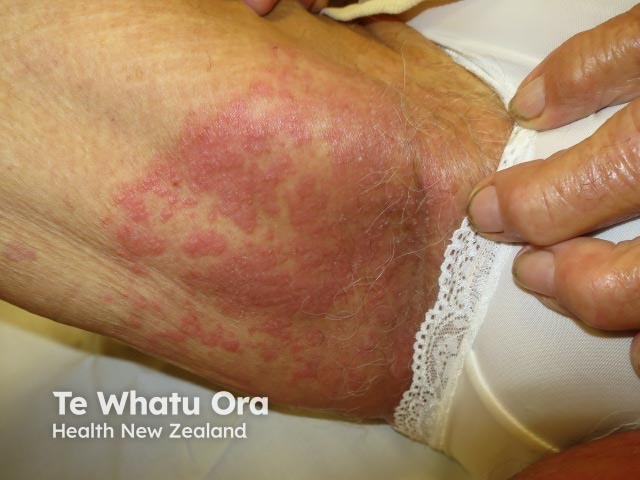
Intertrigo due to candida infection
Erythrasma: Corynebacterium minutissimum
- Persistent brown patches
- Minimal scale
- Asymptomatic (painless and non-itchy)
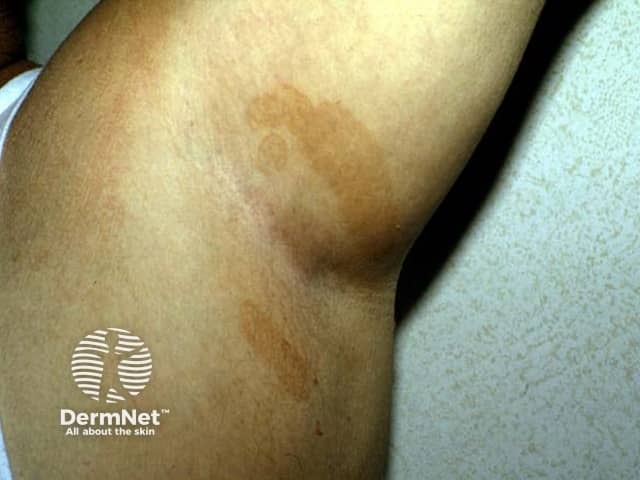
Axillary erythrasma
Tinea: Trichophyton rubrum + T. interdigitale
- Tinea cruris (groin) and athletes foot (between toes)
- Slowly spreads over weeks to months
- Irregular annular plaques
- Peeling, scaling
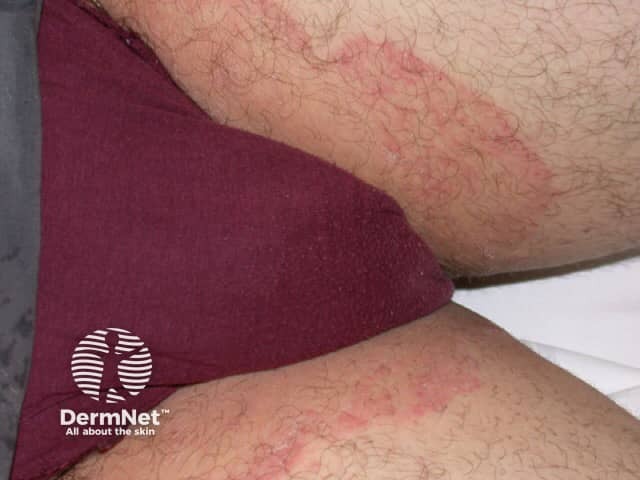
Tinea cruris
Impetigo: Staphylococcus aureus and Streptococcus pyogenes
- Rapid development
- Moist blisters and crusts on a red base
- Contagious, so other family members may also be affected
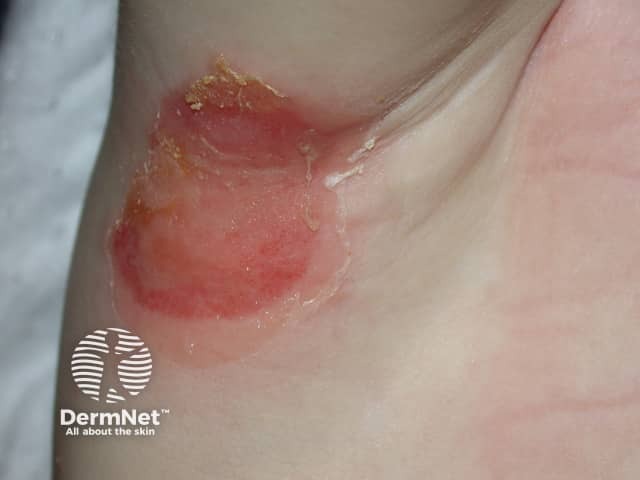
Bullous impetigo
Boils: Staphylococcus aureus
- Rapid development
- Very painful follicular papules and nodules
- Central pustule or abscess

Boil
Folliculitis: Staphylococcus aureus
- Acute or chronic
- Superficial tender red papules
- Pustules centred on hair follicles
- Can be provoked by shaving, waxing, epilation.
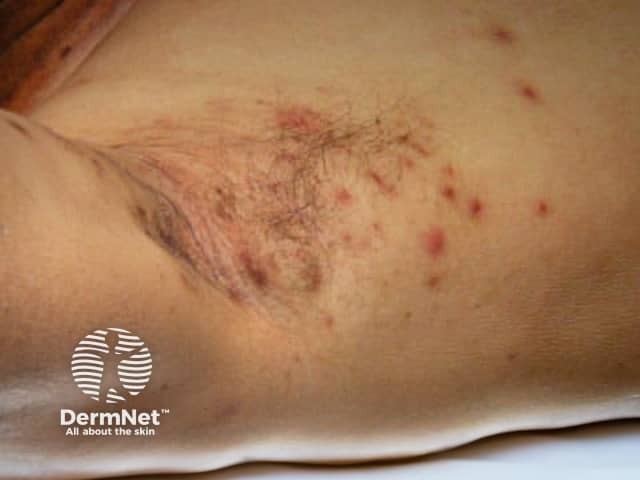
Folliculitis in axilla
Skin inflammations causing intertrigo
- Well-defined, smooth or shiny red patches
- Very persistent
- Common in submammary and groin creases
- Symmetrical involvement
- May fissure (crack) in the crease
- Red patches on other sites are scaly
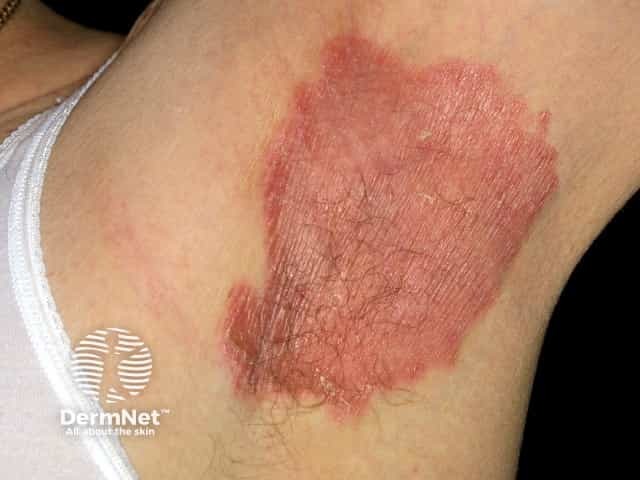
Flexural psoriasis
- Ill-defined salmon-pink thin patches
- Common in axilla and groin creases
- Fluctuates in severity
- May be asymmetrical
- Often unnoticed
- Red patches on the face and scalp tend to be flaky.
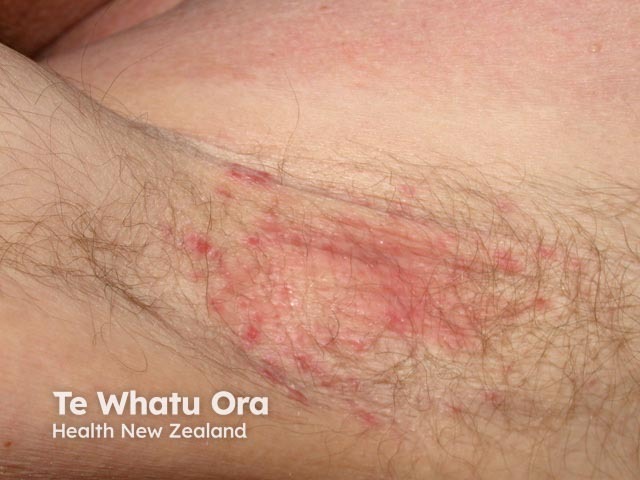
Intertrigo due to seborrhoeic dermatitis
- First occurs in infancy
- Common in elbow and knee creases
- Characterised by flares
- Very itchy
- Acute eczema is red, blistered, swollen
- Chronic eczema is dry, thickened, lined (lichenified).
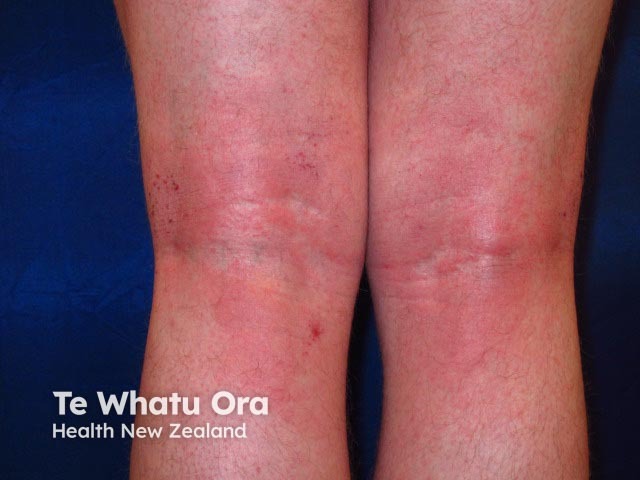
Flexural eczema
- Acute, relapsing or chronic
Irritants include:
- Body fluids: sweat, urine
- Friction due to movement and clothing
- Dryness due to antiperspirant
- Soap
- Excessive washing.

Contact irritant dermatitis due to urine. Napkin dermatitis in adult
- Acute or relapsing
- The allergen may be:

Intertrigo due to contact allergy to benzocaine
- Chronic disorder
- Boil-like follicular papules and nodules
- Discharging sinuses and scars
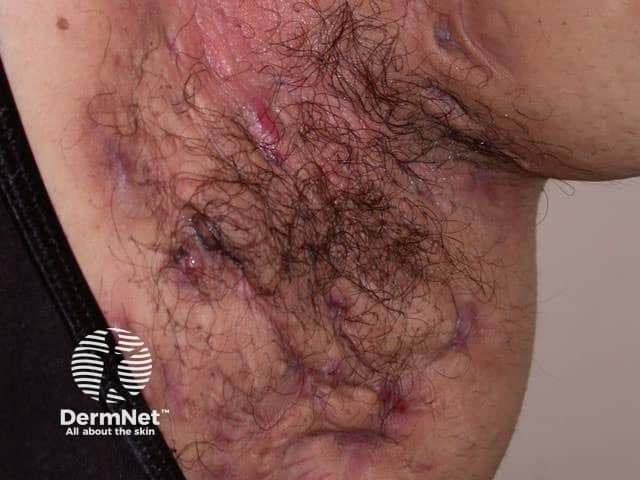
Intertrigo due to hidradenitis suppurativa in axilla
- Intermittent painful shallow blisters that quickly break down
- Rare inherited condition
- Often starts age 20–40 years
- Most troublesome during summer months
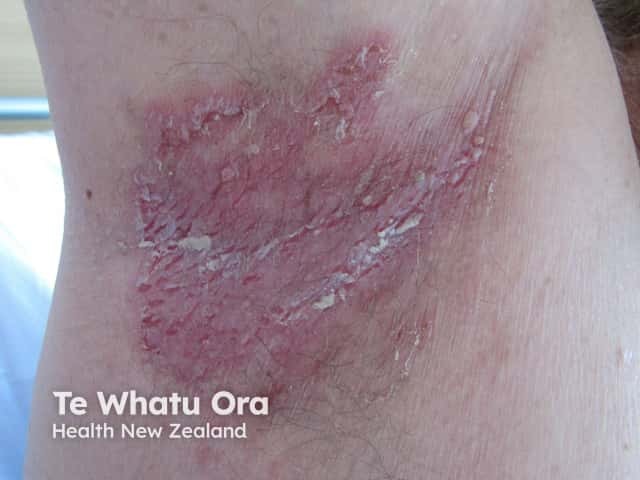
Intertrigo due to Hailey-Hailey disease
- Red-brown scaly rash
- Can be itchy
- Rare
- A biopsy is essential for diagnosis.
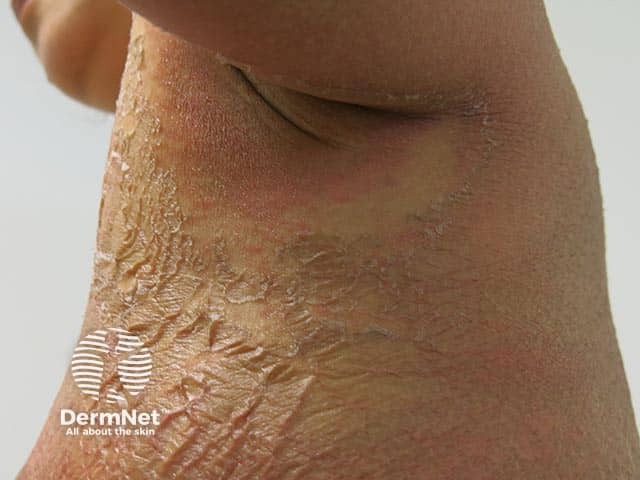
Granular parakeratosis
- Dome-shaped follicular papules in armpits
- Often persistent
- Asymptomatic or itchy
- Reduced sweating
- Excoriations and lichenification eventually occur as a result of scratching.
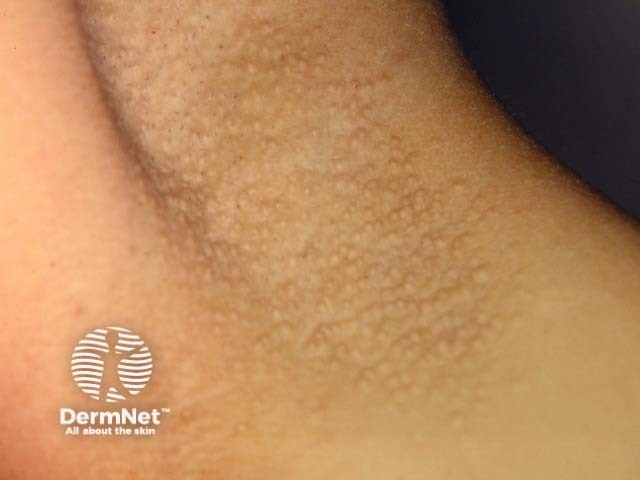
Axillary Fox-Fordyce disease
Toe-web intertrigo
- Common in persons wearing tight-fitting shoes
- Pseudomonas aeruginosa is the most common organism
- Mild toe-web intertrigo presents with erythema and scaling (athlete's foot)
- Chronic intertrigo (longer than six months) causes burning pain, exudation, maceration, and inability to move the toes
- A serious complication is cellulitis, often spreading to ankles and knees.
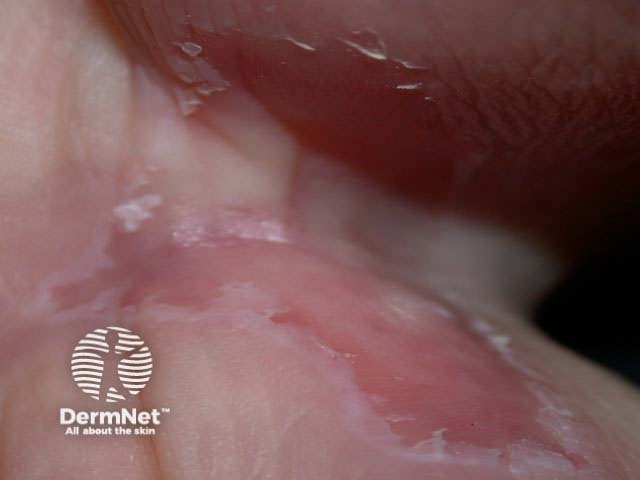
Athlete's foot
What investigations should be done?
Investigations may be necessary to determine the cause of intertrigo.
- A swab for microscopy and culture of bacteria (microbiology)
- A scraping for microscopy and culture of fungi (mycology)
- A skin biopsy may be performed for histopathology if the skin condition is unusual or fails to respond to treatment.
What is the treatment for intertrigo?
- Treatment depends on the underlying cause if identified, and on which micro-organisms are present in the rash. Combinations are common.
- Zinc oxide paste can be used for napkin dermatitis or incontinence-associated irritant contact dermatitis.
- Physical exertion should be followed by bathing and completely drying skin flexures. A hairdryer on cool setting is an effective approach for drying underarms and breasts.
- Sweating can be reduced with an antiperspirant cream or powder.
- Bacterial infection may be treated with topical antibiotics such as fusidic acid cream, mupirocin ointment, or oral antibiotics such as flucloxacillin and erythromycin.
- Yeasts and fungi may be treated with topical antifungals such as clotrimazole and terbinafine cream or oral antifungal agents such as itraconazole or terbinafine.
- Inflammatory skin diseases are often treated with low potency topical steroid creams such as hydrocortisone. More potent steroids are best avoided in the flexures because they can cause skin thinning, resulting in stretch marks (striae atrophicae) and rarely, ulcers. Calcineurin inhibitors such as tacrolimus ointment or pimecrolimus cream are also effective in skin folds.
References
- Janniger CK, Schwartz RA, Szepietowski JC, Reich A. Intertrigo and common secondary skin infections. Am Fam Physician 2005; 1; 72: 833–8. Journal
- Tüzün Y, Wolf R, Baglam S, Engin B. Diaper (napkin) dermatitis: a fold (intertriginous) dermatosis. Clin Dermatol 2015; 33: 477–82. PubMed
- De Britto LJ, Yuvaraj J, Kamaraj P, Poopathy S, Vijayalakshmi G. Risk factors for chronic intertrigo of the lymphedema leg in southern India: a case-control study. Int J Low Extrem Wounds 2015; 14: 377–83. doi: 10.1177/1534734615604289.PubMed
- Martín EG, Sánchez RM, Herrera AE, Umbert MP. Topical tacrolimus for the treatment of psoriasis on the face, genitalia, intertriginous areas and corporal plaques. J Drugs Dermatol 2006; 5: 334–6. PubMed
- Weidner T, Tittelbach J, Illing T, Elsner P. Gram‐negative bacterial toe web infection–a systematic review. J Eur Acad Dermatol Venereol 2018; 32: 39–47. PubMed
On DermNet
Other websites
- Intertrigo — Medscape Reference
